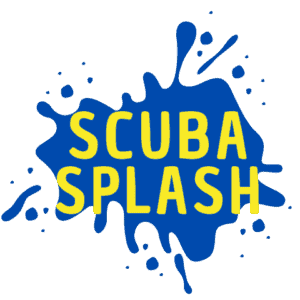If you are a scuba diver and have yet to experience what it’s like to swim along coral reefs then you are in for a world of excitement. For all those divers who have taken trips to coral reefs then you know better than anyone else how exhilarating it is. Diving along healthy coral reefs is at the top of every scuba enthusiast’s list.
Coral reefs offer vibrant colors, interesting formations, and tons of marine life. They support huge amounts of species because they offer shelter and sources of food. Divers love coral reefs for their colors, photography opportunities, and for dense fish populations.
So what are coral reefs anyway? Coral reefs are underwater ecosystems formed by colonies of coral polyps that build off each other. Even though most people think coral reefs are plants they are actually classified as animals. Coral reefs are sometimes referred to as the ‘rainforests of the ocean’ and support 25% of all marine life.
Let’s dive right into our top 10 list of best countries to scuba dive along coral reefs. The list below is numbered in order of countries with the greatest surface area of coral reef. Each category includes the very best dive locations for coral reefs and relative diving information.
10.) Bahamas
Coral Reef: 1,216 sq miles/ 3,150 sq km
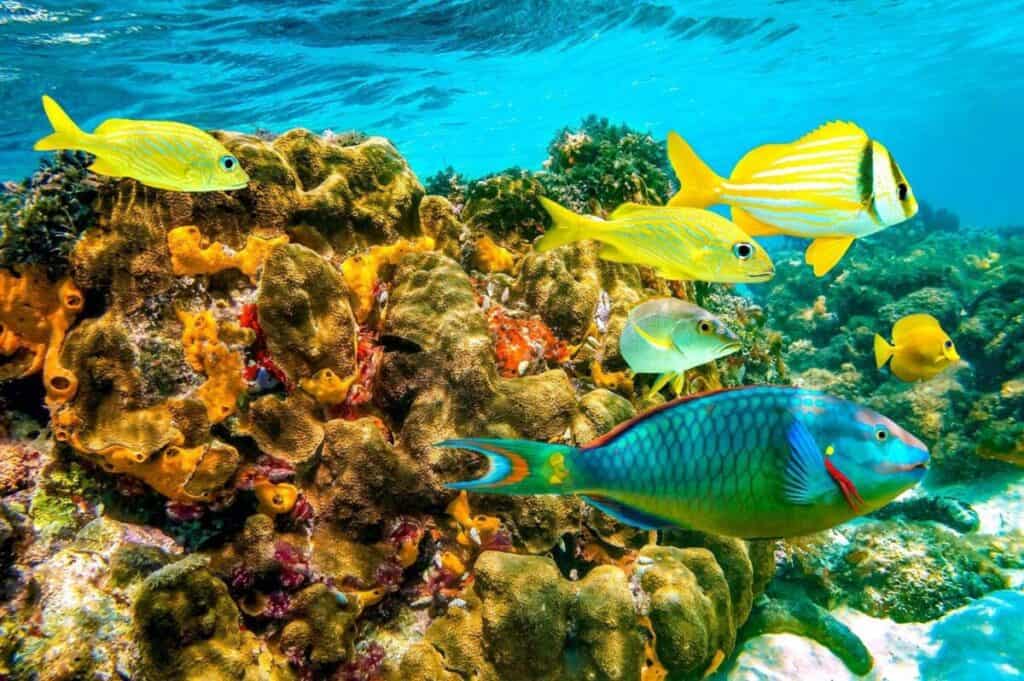
The Bahamas is a fantastic dive location for all levels of divers including anyone wanting to learn scuba or get certified. The waters that surround the area are warm and most are only 20 feet (6 m) deep.
There are reef systems for all levels of divers from true beginners to experts. Even if you are curious about diving the Bahamas is an ideal place to take a scuba course and get certified.
The Bahamas is an archipelago consisting of 700 islands. The reef systems are very healthy in the area and are respected as not only tourist attractions but vital aspects of the local ecosystem.
The Bahamas contains 50 different species of coral. Some of these species include: elkhorn, staghorn, sea whips, lettuce, brain, plate, needle, and fans.
The best reef sites include:
- Andros Barrier Reef, Andros Island: The third-largest barrier reef in the world at 190 miles (306 km) long. The wall drops to 88 feet (27 m) depth and houses 160 different species of fish and coral.
- Runway Wall, Nassau: Reef walls and a hotspot for Caribbean reef sharks. The reef is in shallow waters at a depth of only 39 feet (12 m). It’s definitely the spot to go to if you want to see sharks.
- The Cays, The Abacos: Fowl, Sandy, and Pelican Cay are filled with reefs dropping to 60 feet (18 m) depth. There are coral caverns, tall coral trees, and schools of tropical fish.
- Victory Reef, Bimini Islands: A 5-mile reef filled with caverns, swim-through, sea sponges, and large marine life like turtles and sharks.
- French Bay Wall, San Salvador Island: Reef wall that drops to 150 feet (46 m) depth filled with overhangs, tunnels, and swim-throughs
- Amberjack Reef, Exuma: The reef is located at a depth of 50 feet (15 m) where tons of schools of fish are always swarming. Jacks, grouper, and reef sharks are the most common but you will also see plenty of pirate blennies and garden eels.
- Vicky’s Reef, San Salvador: Coral ridges line the top of drop-offs with black coral trees and sea sponges lining the ridges. The reef measures in width from 50-120 feet (15-36 m). The drop-off starts at 40 feet (12 m) depth and goes down to 140 feet (42 m).
The Bahamas is also home to 40 different species of sharks including, tiger, hammerhead, reef, silky, bull, lemon, and oceanic whitetip. The best months to see sharks are from October through June.
Read More: 11 Unique Places to Dive in the Bahamas
The Bahamas is a year-round diving destination though hurricane season runs from June through October. Water temperatures range from 75-88° F (24-31° C) and visibility is 79-98 feet (24-30 m).
Fun Facts: Since coral needs sunlight to grow they usually aren’t found in waters deeper than 45 feet (14 m).
9.) Malaysia
Coral Reef: 1,390 sq miles/ 3,600 sq km
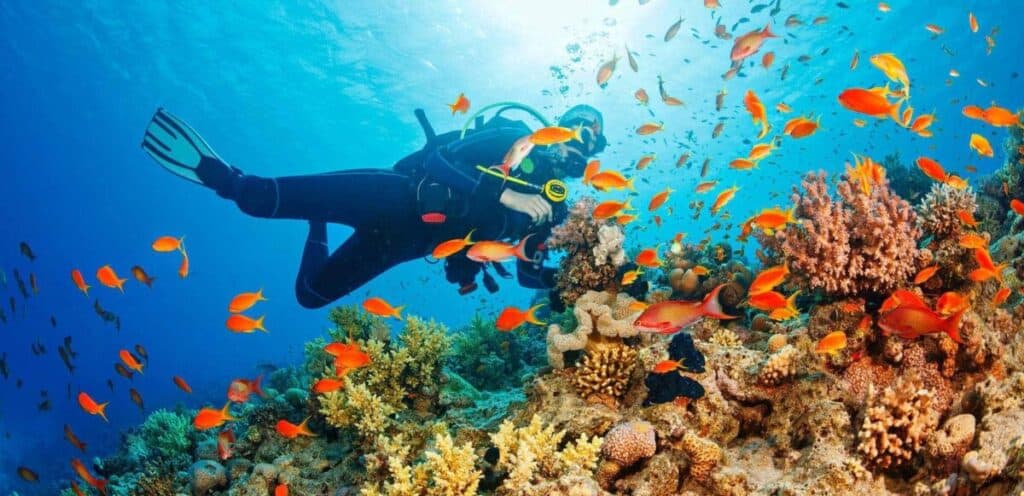
Malaysia is a tropical country located in the Pacific Ocean near Thailand and Indonesia. It just so happens to be an amazing dive destination sometimes overlooked by the mainstream crowd. This works to your advantage because fewer crowds mean better reef conditions and easier access.
Malaysia offers just about everything for all levels of divers. From drop-offs and shipwrecks to atolls and marine parks you can dive here for months without seeing it all. There is also a dense fish population that includes sharks, barracuda, snapper, triggerfish, eel, turtles, octopus, parrotfish, and pufferfish.
All divers will appreciate the calm waters in Malaysia and easy water entries. The best time to dive in Malaysia is from March through October with water temperatures ranging from 80-88 F (27-31 C).
Malaysia boasts 550 different species of coral including: brain, cauliflower, leaf, staghorn, grape, pearl bubble, lettuce, frogspawn, mushroom, sea fans, and sea whips. 42.5% of the coral in Malaysia is living and healthy but this percentage declines by about 1% each year. Certain islands have more thriving coral reefs than others but they are surveyed annually to help preservation efforts.
Snapper, butterflyfish, grouper, sweetlips, and moray eels are the most abundant species of fish found in Malaysia and near reef sites. These types of fish actually help to keep reef ecosystems alive by feeding on coral polyps and controlling algae growth.
The best reef sites in Malaysia are:
- Tiger Reef, Tioman: This seamount pinnacle has wonderfully bright coral formations including sea whips, sea fans, and sea lilies. Large schools of jacks, mackerel, and barracuda swim alongside eels, stingrays, and lionfish.
- Layang Layang Island: A cluster of 13 coral atolls featuring walls, drop-offs, scalloped hammerhead sharks, gorgonian coral forests, sea fans, sponges, and sea whips.
- Sipadan Island: Highly sought dive site featuring an extinct submerged volcano covered in hundreds of years of coral growth. Expect to see coral gardens, sponges, barracuda, jacks, and turtles.
- Redang Island: Famous for its soft coral, gorgonian sea fans, coral gardens, and sea turtles. There are also hard coral formations along with fringing reefs.
- Tenggol Island: Over 20 dive sites at the island featuring fringing reef, massive walls, drop-offs, boulders, shipwreck, humphead parrotfish, and turtles.
- Tioman Island: Plenty of hard and soft coral formations, sea fans, shipwrecks, macro marine life, coral gardens, swim-throughs, caves, canyons, boulders, and more fish than you could ask for.
- Satang Island: Two-thirds of this island is surrounded by reefs. There are fringing reefs, soft coral, sea fans, pufferfish, and WWII shipwrecks.
Scuba diving is a year-round activity in Malaysia but visibility peaks in July and August at over 131 feet (40 m). Water temperatures range from 77-86° F (25-30° C). Liveaboard trips are common and ideal for maximizing your dive time along the reefs.
Fun Facts: There are three main types of coral. Barrier reefs, fringing reefs, and coral atolls.
8.) Vanuatu
Coral Reef: 1,587 sq miles/ 4,110 sq km
You might not of heard of the country of Vanuatu but they have some of the most spectacular diving in the world. Vanuatu is comprised of 80 islands with 67 of them inhabited and is located in the Western Pacific Ocean.
The waters are warm with high visibility and the reef systems are vibrant and plentiful. There are dive sites for all levels of divers including people looking to get certified. Yes, coral reefs are certainly the highlight of Vanuatu diving but the country also offers caves, lagoons, shipwrecks, drop-offs, and technical diving.
In 2003 a team of researchers from IRD (Institute for Research and Development France) dated a reef off Urelapa Island, Vanuatu as being 23,000 years old. Officially the oldest dated reef today. The reef also holds the record for longest continuous growth at 17,000 years.
Some species of coral reefs found in Vanuatu include: staghorn, plate, brain, pinnacle, table, elkhorn, and whips. There are also a wide array of coral formations such as lagoons, platforms, barrier, and fringing reefs.
The best reef sites in Vanuatu are:
- Twin Bombies, Port Vila: A Reef wall that drops to 59 feet (18 m) along with grottos filled with colorful coral formations.
- Ollies Lolli, Hideaway Island: This site is a large bommie with hard and soft corals. Large red anemones live here along with plenty of tropical fish species.
- Owen’s Reef, Tranquillity Island: Vast amount of coral species including pinnacle, brain, and staghorn along with soft coral and sea fans. This site is jaw-dropping and you won’t be able to count how many species of coral are present. There are also overhangs and tunnels covered in sea fans, whips, and soft coral formations.
- Mele Reef: This large reef in the middle of Mele Bay has a vertical wall and is great for beginners. The reef starts just 19 feet (6 m) below the surface. There are also two shipwrecks in the bay that can be visited.
- West Side Story, Hideaway Island: Staghorn coral gardens stretching nearly 100 feet (30 m) high.
- Aore Wall, Aore Island: Home to massive sea fans, hard coral cling to a vertical wall that drops to 115 feet (35 m) deep. Lots of macro life and a stunning site for photography.
- Tutuba Point, Tutuba Island: Located on the northern tip of Tutuba Island, this site features hard and soft coral, caves, swim-throughs. Along with the lush marine life, turtles and sharks are common visitors.
There are tons of fish in Vanuatu with over 300 species of reef fish alone. Some of the species you will see are snapper, paeony, large-eye bream, grouper, jobfish, emperor, and yellowtail. There are also several species of sharks including silky, mako, blue, hammerhead, bronze whaler, sandbar, thresher, and oceanic whitetip.
The best time to scuba dive in Vanuatu is from May through December. Cyclone season is December to April and the country does experience storms during these months. Water temperatures range from 70-80° F (21-27° C) and visibility goes all the way up to 160 feet (49 m).
Fun Facts: Coral bleaching is when coral expels the algae living inside which cuts off their nutrient supply and causes them to slowly starve. Bleaching is trigger by stress, pollution, and increased sea temperatures.
7.) Marshall Islands
Coral Reef: 2,220 sq miles/ 5,750 sq km
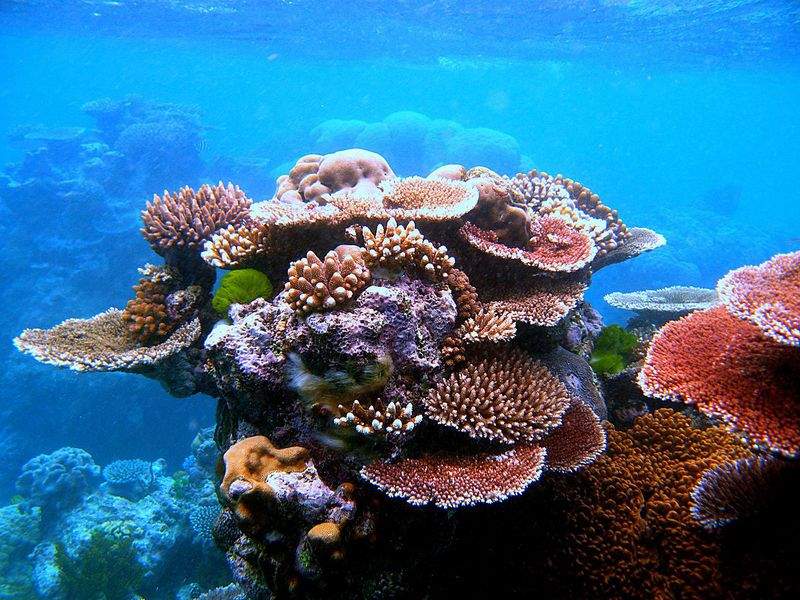
The Marshall Islands are made up of over 1,000 islands and 29 atolls and is located between Australia and Hawaii. This region is remote but worth the trip if you are looking for pristine diving conditions.
This region is not as widely explored by divers as other destinations which means the reefs are in better condition and the sites are never busy. If you come to the Marshall Islands it’s to dive. The area is underdeveloped as far as tourism is concerned but you can find accommodation on atolls such as Majuro and Arno and on Ebeye Island.
The Marshall Islands have 870 different reef systems spread throughout the territory. There are 300 different species of coral around the islands including both hard and soft varieties. Stony, elkhorn, blue, staghorn, lace, cauliflower, moon, cactus, plate, sea fans, and sea sponges are just a few of the species you will encounter.
The best reef sites in the Marshall Islands are:
- Majuro Atoll: Coral pinnacles, massive schools of jacks, and an underdeveloped diving location. Dive sites are still being discovered and reefs are untouched with no tourist damage. This atoll is one of the easiest to travel to and stay on with accommodation and food options.
- Kwajalein Atoll: A battleground during WWII and the site where the US intentionally sunk many planes. There are at least 100 planes around the atoll that can be explored. Brightly colored anemones, sea sponges, and coral formations sprout from the wreckage.
- Rongelap Atoll: A very specific species of coral called Acropora Rongelapensis is found here. This is a branching coral that grows up to 8 inches (20 cm) across and 4 inches (10 cm) long. As of right now, this atoll is the only place in the world this species of coral exists. This atoll houses some highly interesting coral formations and is revered by many as a coral heritage site. Rongelap is hardly explored by divers and many areas have yet to be discovered or even named for that matter.
- Bikini Atoll: A former nuclear testing site during the 40s and 50s and known as a graveyard for lots of WWII shipwrecks and planes. There is also an abundance of sharks and other marine life. Bikini Atoll is regulated and only allows a certain number of divers each year. It’s a spot for experienced divers and bookings should be made ahead of time. Trips run from April through November.
- Arno: 10 foot (3 m) sharks and 200 pounds (91 kg) sea turtles set in crystal clear waters and untouched dive sites. Most of the area has yet to be explored by divers and all the reefs are in perfect condition. The easiest way to visit this site is on a liveaboard trip.
Some of the species of sharks commonly seen include whitetip, grey, blacktip, silky, Galapagos, and Oceanic whitetip. The sharks are able to thrive in the area because the world’s largest shark sanctuary surrounds the islands and measure 768, 547 sq miles (1,990,527 sq km). It is designed to prevent commercial shark fishing, possession, and trading.
Along with the sharks, there are tons of species of fish. Some of the most common include grouper, barracuda, jacks, snapper, sergeant, tang, goby, wrasse, surgeonfish, tuna, and turtles.
The dive season runs from May through October with cyclone season lasting from November through April. Water temperatures are 80-86° F (27-30° C) and visibility ranges from 33-131 feet (10-40 m) depending on the location and month.
Liveaboard boats are a common way for divers to maximize their time on the islands and see much more. The liveaboard ships run from May through August and range in length from 3 to 14 days. To ensure that you see everything you want, book your liveaboard trip before arriving.
Fun Facts: There are 6,000 different species of coral.
6.) Maldives
Coral Reef: 3,444 sq miles/ 8,920 sq km
The Maldives is an archipelagic made up of 26 atolls and over 1,000 coral islands. It is located in the Arabian Sea and is 1,331 miles (2,142 km) from India. There are over 200 dive sites in the Maldives so that should be enough to keep you busy for a little while.
If you love interesting terrain then you will love the Maldives. The islands are full of channels, passageways, atolls, lagoons, drop-offs, walls, pinnacles, caves, canyons, wrecks, and coral reef formations. There is also a vast fish population with dive sites that range from beginner to advanced.
There are 250 species of hard and soft coral on the islands. Some of the species you will see include staghorn, brain, finger, blue, table, cauliflower, hump, bubble, elephant skin, and honeycomb. Due to climate change and rising sea temperatures, many of the coral reefs in the Maldives have experienced some level of bleaching. The reefs are slowly recovering and there are still many excellent coral reef dive locations.
The best reef sites in the Maldives are:
- Banana Reef, North Male Atoll: Wildy diverse and colorful reef with caves, overhangs, walls, crevices, and dense fish populations. The reef starts at 16 feet (5 m) and drops down to 115 feet (35 m). Jacks, grouper, snapper, wrasse, napoleons, and eels are always spotted near the reef.
- Jaluit: Massive hard coral formations
- Fish Head, North Ari Atoll: Also known as ‘Shark Point‘ is a shark lover’s dream with at least 20 grey nurse sharks wandering around. Inside this protected marine park you will also see a pinnacle, walls, caves, overhangs, black coral, fusiliers, trevally, barracuda, and wrasse. The main reef begins at a depth of 33 feet (10 m) and goes down to 131 feet (40 m).
- Ari Atoll: There is a 60 foot (24 m) long pinnacle, black coral bushes, channels, caves, overhangs, drop-offs, and walls. It’s common to see grey nurse sharks, manta rays, and schools of snapper in the thousands. Hammerhead sharks are also seen swimming around in groups. The current can be strong and most dives are drift.
- Baa Atoll: A UNESCO Biosphere Reserve with swim-throughs, overhangs, canyons, reef systems, coral gardens, hard and soft coral, jacks, rays, and sharks. This dive site has some of the most diverse marine life populations in all of Maldives.
- Vaavu Atoll: Swim-throughs, caves, overhangs, and famous colorful soft coral formations. Pink, green, and yellow soft coral hang on the inner areas of the channels of the Golden Wall and are a must-see.
There are over 1,000 species of fish here and 27 species of sharks. The most commonly seen fish are tuna, trevally, wrasse, snapper, grouper, triggerfish, parrotfish, tangs, butterflyfish, goldies. You are likely to see shark species such as zebra, nurse, whale, blacktip, leopard, silky, oceanic whitetip, lemon, Caribbean, silvertip, and guitar. You’ll probably see at least a few on every dive. Apart from the sharks, you can expect to see dolphins, rays, and eels.
Diving is a year-round activity in the Maldives however the weather gets a little turbulent from May through July. You can still dive but visibility is reduced. Water temperatures are quite regular and range from 79-84° F (26-29° C). Visibility ranges from 49-131 feet (15-40 m) depending on the time of year.
The majority of dive locations around the Maldives are visited from liveaboard trips. You really do get your money’s worth on liveaboards. The price includes accommodation, meals, gear, and up to 3 dives each day. Find the trip that suits your timeline and budget and don’t forget to checkout the reviews.
Fun Facts: Algae live inside of coral reef structures and act as a food source. The algae are also what gives coral its vibrant color.
5.) Fiji
Coral Reef: 3,869 sq miles/ 10,020 sq km
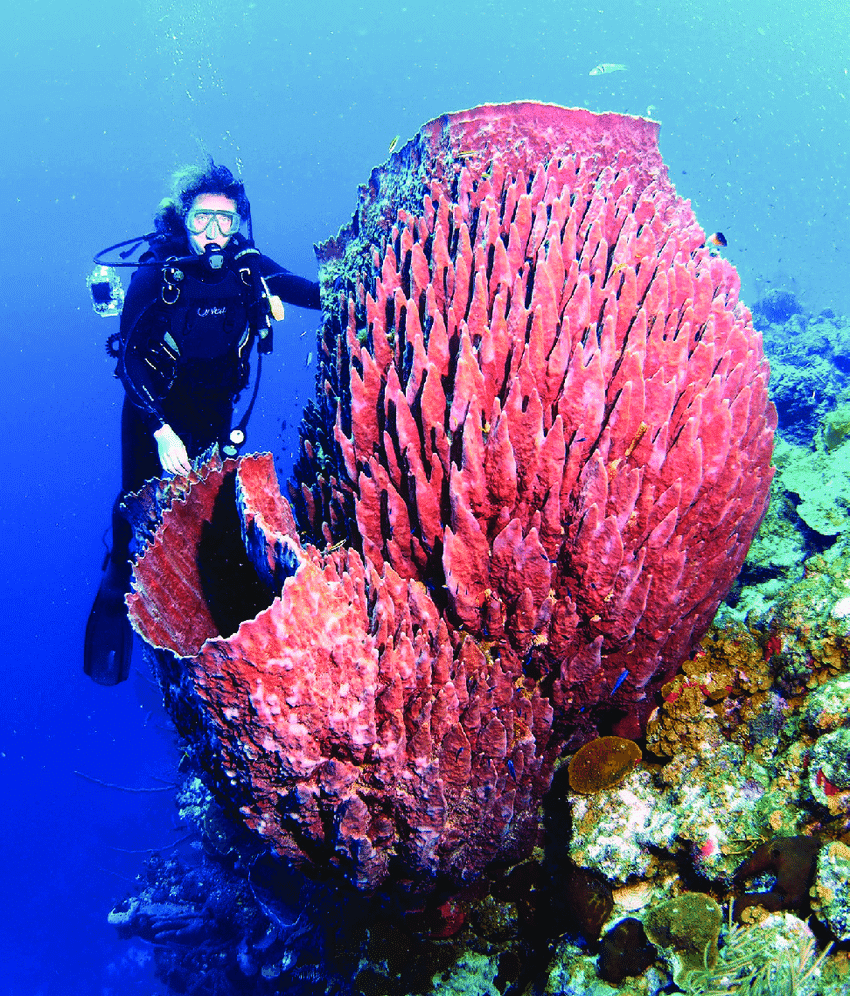
Fiji is an archipelago of 300 islands and is located in the South Pacific Ocean just 2,886 miles (4,644 km) from Australia. The country is dubbed the ‘Soft Coral Capital of the World’ for the lush and vibrantly colored formations found all around the waters.
Fiji is often associated with a high price tag and expensive resorts however this is not the case. Fiji is actually one of the most affordable places to scuba dive in the South Pacific Ocean. Two tank dives average $150 USD, an open water certification course is $620 USD, and accommodation starts at $15 USD per night and goes up.
Fiji is home to 390 different species of coral including both hard and soft varieties. The diverse range of colors in the coral in Fiji is almost unmatched. Orange, pink, purple, blue, yellow, and black are just a few of the colors you will see. The species of coral found in the waters surrounding Fiji include staghorn, elkhorn, brain, leather, finger, stony, table, green slimer arco, whips, and soft tree along with fans and sponges.
The best reef sites in Fiji are:
- Namena Marine Reserve, Savusavu: A protected marine reserve that houses a barrier reef with vibrant hard and soft corals. There are several dive sites here with include pinnacles, bommies, sharks, tropical fish, and sea horses.
- Beqa Lagoon, Viti Levu: Tall pinnacles covered in soft coral formations, reef systems, and tons of tropical fish. There are 9 species of sharks that roam the lagoon and it’s regarded as a prime site for shark diving.
- Vatu-I-Ra Passage, Viti Levu: Soft and hard corals and larger species of marine life like sharks, humphead wrasse, and turtles. You will also find thick layers of anemones covering sections of the reef, huge populations of fish, canyons, bommies, and passageways.
- Astrolabe Reef, Kadavu: The world’s 3rd largest barrier reef with several dive spots. Manta rays are frequently seen passing through the numerous channels and passageways.
- Sososomo Strait, Taveuni: Several coral bommies, a vertical wall that drops to 85 feet (26 m), and amazing coral formations. White, purple, and yellow soft corals suspend from the tunnels at the Great White Wall and Rainbow Reef. Sea sponges, gorgonian fans, and sea whips are seemingly everywhere with octopus, lionfish, and rays gliding through.
Fiji has 1,500 different species of fish and 5 of the world’s 7 species of sea turtles. The best months to see turtles are October through April. Sharks, whales, dolphins, and rays are seen year-round and common at most dive sites.
Scuba diving is amazing year-round but the very best visibility is from July through November. Cyclone season is November through March but diving is still possible during these months. You can expect visibility to range from 70-130 feet (21-39 m) and water temperatures from 74-86° F (23-30° C).
Fun Facts: 25% of all sea life are supported by coral reefs.
4.) France
Coral Reef: 5,513 sq miles/ 14,280 sq km
When you think about France you might assume the entire country is located in Europe. Unfortunately, there are almost no corals in Europe because of the water conditions. However, France has 13 territories in the Caribbean, South Pacific, and the Indian Ocean. Most of these territories have some impeccable diving and pristine coral reefs. A few of these such territories include Guadeloupe, French Polynesia, Saint Martin, New Caledonia, and Martinique.
France might get overlooked as a dive location but it has a lot to offer. Apart from the glorious reefs, there are some amazing caves, channels, drop-offs, lagoons, fringing reefs, and wrecks for beginners all the way up to technical divers.
There are several hundreds of species of coral reefs within French territories. The corals are well studied and documented to help preserve them and keep them healthy. Some of the species of coral you will find in French territories include brain, table, branch, staghorn, plate, finger, vase, elkhorn, pillar, cauliflower, starburst, ball, sea fans, and sponges.
The best reef sites in France are:
New Caledonia
- Dumbea Passe, Noumea: A large channel with massive gorgonian fans, black coral, canyons, caverns, a WWII submarine, several species of sharks, and hundreds of grouper.
- Le Jardin d’Eden, Isle of Pines: Translated to English the name of this site is ‘The Garden of Eden’ and it earns its name. Coral formations, grottos, canyons, tunnels, swim-throughs, walls, drop-offs, and gardens of hard and soft coral. The coral wall drops down to 147 feet (45 m) and visibility is almost always 98 feet (30 m).
- Gorgone Reef, Lifou: Giant colorful gorgonian sea fans, endless clusters of coral reef formations, barracuda, tuna, turtles, dolphins, and leopard sharks are just a few of the things you will see.
Saint Martin
- Japanese Garden, Tintamarre: Located at a depth of 60 feet 29-69 feet (9-21 m) this reef formation is full of both hard and soft coral. There is a sandy bottom canyon and a coral garden off to the side of the main reef. The coral is vibrant and in very healthy condition. Lobsters, stingrays, turtles, and nurse sharks are commonly seen here.
- Circus, Tintamarre: Caves, caverns, a wall, and swim-throughs encrusted with coral formations, sea sponges, and fans. This site nothing but fun and a wonderful place to polish your buoyancy skills. Lobsters, glassfish, and dolphins are almost always seen here.
- Fish Bowl: Healthy and vibrant coral formations, sea sponges, sea fans, tunnels, canyons, and tons of fish. There’s even an archway to swim through and plenty of reef sharks nearby.
French Polynesia
- Fakarava Atoll: Second largest atoll in French Polynesia. The lagoon houses 2 massive channels, one with a strong current for drift diving and the other calm and shallow for relaxed dives. Be prepared to see hundreds of sharks including hammerheads and grey nurse. There are also barracuda, trevally, and tuna as well.
- Tupitipiti and Anau, Bora Bora: In Tupitipiti there is a massive reef formation with caves, overhangs, and swim-throughs. The reef is vibrant with green and orange sea sponges and tons of marine life. Anau is famous for its stunning coral garden almost too amazing to be real. It also doubles as a manta ray cleaning station. Anau is protected so you will need to book your spot ahead of time.
- Moorea Island: This island is surrounded by a fringing reef, crystal clear waters, and virtually no current. There is tons of diving around the island. At Opunohu Coral Wall there are canyons, coral walls, coral gardens, sharks, turtles, and eels. Rays Corridor Drift is a drift dive along a lagoon channel with white sandy slopes, vibrant coral walls, schools of eagle rays, white tip sharks and plenty other marine species.
- Raiatea Island: Vertival reefs, lagoons, drop offs, channels, caves, and wrecks are just a few of the things to be seen here. Miri Miri is where you will find vast fields of pink monipora corals. Reef sharks, turtles and wrasse cruise through the coral fields.
No matter which territory you decide to visit expect there to be tons of marine life. Whales, dolphins, seals, and huge grouper are commonly seen in the waters. Sharks are seen in the hundreds and there is plenty of small macro life to keep any photographer preoccupied.
Diving is a year-round activity in French territories with consistent temperatures and wonderful visibility. Water temperatures range from 70-85° F (31-29° C) and visibility goes from 197- 328 feet(60-100 m). The visibility is insanely good.
France has very strict rules and guidelines when it comes to scuba diving. One is that they require a doctor’s note verifying that you are fit enough to dive. Another is that there is no reliability release which makes the divemaster responsible for any incidents that may occur. This makes divemasters and guides much more cautious and strict. Though these regulations may be more relaxed in the territories be prepared just in case.
Fun Facts: The Belize Barrier Reef is 190 miles (306 km) long.
3.) Philippines
Coral Reef: 9,676 sq miles/ 25,060 sq km
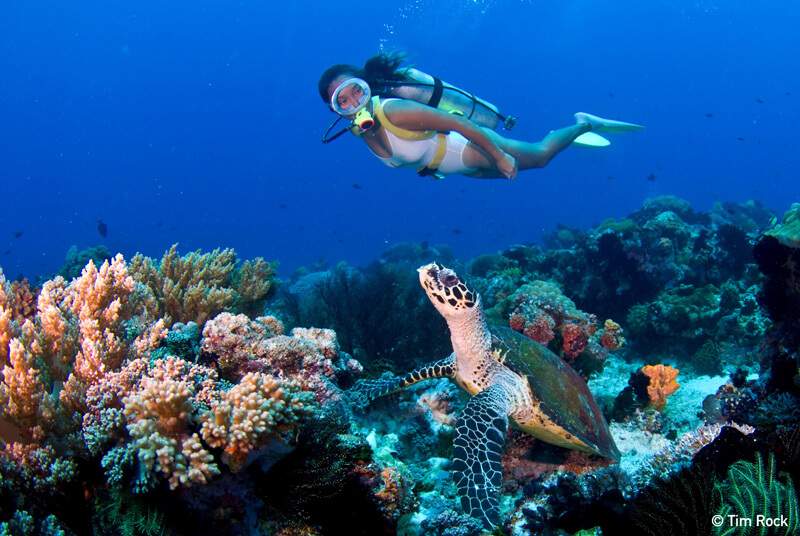
The Philippines is an archipelago made up of 7,100 islands and located between Indonesia and China. The country has some of the most pristine reef systems in the world that are ideal for every level of diver.
From shipwrecks and massive coral reef systems to swarms of millions of sardines, the Philippines is a place every dive needs to experience. Divers have many options from shore dives to liveaboard trips to more distant islands. Even if you want get scuba certified, the Philippines has everything a diver could dream of.
There are 421 species of coral reefs in the Philippines. The Philippines makes up 9% of the total coral reef in the world. Some of the species of coral you will see are sun, stony, mushroom, lettuce, sea pen, octopus, sea whips, joker, lace, bean, disc, bubble, leather, and fire. Be careful not to touch any coral but especially fire coral. They do sting and it hurts.
The best reef sites in the Philippines are:
- Tubbatahub Reef, Palawan: A national park that is a UNESCO World Heritage Site and seen as one of the best dive locations in the Philippines. There are 360 species of coral, 600 species of fish, 11 species of sharks, and so much more all at one park. The dive season is only February to June and the easiest way to see it is on a liveaboard ship.
- Dauin, Dumaguete: Artificial reefs, shipwrecks, soft coral gardens, macro life, unique sea creatures, sloping reefs. Currents are sometimes powerful, but the shallow reefs are great for easy/ beginner dives. Atlantis House Reef has black sand, hard corals, and seagrass with turtles, frogfish, and eels wandering through. There are enough dive sites around the town of Duin to keep you busy for weeks.
- Apo Reef, Sablayan: Coral gardens, sloping walls, huge populations of fish, green sea turtles, sharks, rays, and 400 different species of coral. It is the largest reef in the Philippines (13 sq mi/ 34 sq km) and the second-largest continuous reef in the entire world. Apo reef is protected and a UNESCO World Heritage Site.
- Moalboal, Cebu: From November to May there are millions of sardines just off Panagsama Beach. The massive schools of sardines are found year-round but they are the very best during the dry season. Talisay Wall is a sloping wall with caves, tons of black coral, and schools of barracuda. Tuble Reef is a forest of large and colorful sea fans. Magic Point has hard and soft corals along with a diverse range of fish species including frogfish, jacks, and mandarin fish.
- Balicasag Island: 130 foot (39 m) wall, an insane number of jacks and trevallies, Black Forest is where you will find yourself in a tornado of jacks and a colorful reef with both hard and soft coral. Marine Sanctuary is a coral wall with macrolife like nudibranchs, sea horses, and tiny tropical fish.
The Philippines has over 2,500 different species of fish including whales, sharks, jacks, barracuda, trevally, frogfish, mandarin fish, banded pipefish, flying gurnard, cuttlefish, triggerfish, ponyfish, and blue-ringed octopus.
Scuba diving is done year-round in the Philippines but the most ideal months are December through April. Monsoon season is July to September so the waters get more intense during this time. Water temperatures are 81-88° F (27-31° C) and visibility is 16-147 feet (5-45 m). Visibility is at its lowest on certain islands during the monsoon season.
Fun Facts: Portions of the Great Barrier reef in Australia date are 10,000 years old.
2.) Australia
Coral Reef: 18,903 sq miles/ 48,960 sq km
Noone can avoid mentioning Australia when talking about coral reefs. Australia is a treasure trove of reef diving. It’s as simple as walking off a sandy beach into the water and straight over the reef.
While it is true that rising ocean temperatures, pollution, and unethical tourist practices have caused damage to the reefs around Australia. However, the amount of damage actually done as of now is very small compared to the amount of dive sites that Australia offers.
There are 560 different species of coral in Australia including both soft and hard varieties. Some of these include organ pipe, flowerpot, cauliflower, hump, finger, honeycomb, and mushroom.
The best reef sites in Australia are:
- Cairns, Queensland: This is one of the best places to dive along the Great Barrier Reef, the world’s largest barrier reef system. There are numerous sites along the reef which include features such as walls, swim-throughs, coral gardens, turtles, dolphins, and lots of tropical fish. The reef is 1,429 miles (2,300 km) long and open to all levels.
- Osprey Reef, Cairns: Located (120 km) beyond the Great Barrier Reef with exclusive dive sites that have less traffic. The reefs are in amazing condition with both hard and soft coral formations. Larger pelagics, turtles, and a few spots are famous for dense shark populations. There are drop-offs, vibrant walls, swim-throughs, caves, trenches, and bommies. This reef is only reachable via liveaboard ship.
- Ningaloo Reef, Coral Bay or Exmouth: The world’s largest fringing reef measuring 161 feet (260 km) long. The region is packed with coral gardens, canyons, pinnacles, walls, swim-throughs, sharks, massive schools of fish, turtles, whales, sharks, and manta rays. Whale sharks are seen April-July.
- Solitary Islands, Coffs Harbour: A group of 5 islands off the coast of Coffs Harbour with an array of dive sites. Expect to see swim-throughs, drop-offs, pinnacles, sea sponges, hard and soft coral, grey nurse sharks, anemones, and dense fish populations.
- Montgomery Reef, Derby: During low tide, the upper portions of the reef are exposed. The reef is 50 miles (80 km) long. You can organize a boat tour that will arrive right before the reef emerges from the water so you can watch it rise up from the ocean. There are also many shipwrecks along the reef for divers to explore.
There are over 1,600 different species of fish found in Australia including snapper, trout, grouper, bass, emperor, clownfish, Moorish idols, and parrotfish. There are also 17 species of sea snakes and 6 species of sea turtles that live within the Great Barrier Reef.
The wonderful part of diving in Australia is that you can walk off many beach shores and swim a short distance to be over a reef system. You can also join a liveaboard trip and head out to more isolated locations.
You can scuba dive year-round in Australia and experience amazing water conditions. Water temperatures range from 60-86° F (15-30° C) and visibility goes from 49-164 feet (15-50 m) depending on the location and time of year. Generally speaking, the visibility in Australia is fantastic and averages at a minimum of 100 feet (30 m). Visibility is at its very best from August through December. Minke whales can be spotted in June and July along Ribbon Reefs.
Fun Facts: Coral reefs grow just 0.79 inches (2 centimeters) each year.
1.) Indonesia
Coral Reef: 19,699 sq miles/ 51,020 sq km
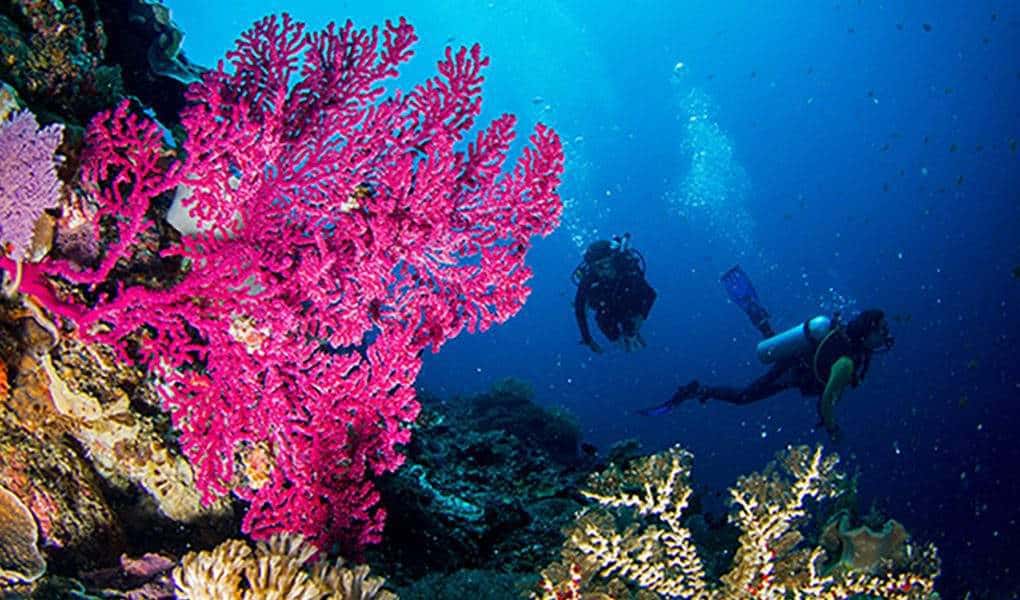
Indonesia consists of 17,000 islands and is located in the Indian and Pacific oceans between Australia and Vietnam. It is one of 6 countries that make up the Coral Triangle. A 2,316,613 sq mile (6,000,000 sq km) area that houses 76% of the world’s species of reefs, 37% of the world’s species of fish, and 6 of the 7 species of marine turtles. All of this diversity in less than 1% of the world’s ocean area.
Scuba diving in Indonesia is diverse, breathtaking, and easily one of the best locations in the world. Indonesian waters contain the world’s highest concentration of coral reef measuring 19,699 sq miles (51,020 sq km). Which is about 800 sq miles (2,072 sq km) more than Australia.
Indonesia has one of the most diverse concentrations of marine life in the world. Not only does the country have a high number of fish species but they have the most coral reef in all the world. There are 590 species of hard and soft coral in Indonesia. A staggering 18% of the world’s total reefs are located in Indonesian waters.
Some species of coral found in Indonesia include sheet, cabbage, staghorn, mushroom, elkhorn, leaf, table, stony, lace, fire, leather, organ pipe, fans, and sponges.
The best reef sites in Indonesia are:
- Raja Ampat, West Papua: Known as one of the very best dive sites in the world with vibrant and dense coral reef formations, walls, pinnacles, sharks, whales, dolphins, turtles, rays, shipwrecks, and more. There are 553 species of coral around Raja Ampat. Divers are known to see several hundreds of varieties of fish one every dive. Jef Fam Islands are home to 72% of the world’s coral species, giant clams, and white banded sea snakes.
- Alor, East Nusa Tenggara: Well worth the effort to get to this island as it is considered one of the best diving hidden gems. Diverse corals, walls, drop-offs, pinnacles, channels, swim-throughs, schools of fish in the hundreds, macro life,
- Komodo, East Nusa Tenggara: National park, Here you will find walls, drop-offs, shallow reefs, coral gardens, pinnacles, sharks, dense fish populations, and macro life. Giant swarms of manta rays frequent the island from November to March. Strong currents make this location best for intermediate divers.
- Togian Islands, Sulawesi: These islands are quiet, remote, and harbor pristine reefs. The virtually untouched dive sites including a WWII bomber wreck, caves, channels, coral atolls, walls, drop-offs, 30 different coral gardens, massive red and green tube sponges, along with massive schools of fish, and reef sharks.
- Wakatobi Islands, Sulawesi: Part of a National Park and is home to Indonesia’s largest Barrier reef. These 4 islands are underexplored by divers making the reefs some of the very best in the region. Expect to see walls, drop-offs, overhangs, coral gardens, massive sea fans, dense fish populations, and macro life.
Indonesia also has a diverse population of fish species. There are over 3,000 different species of fish which is more than Australia (1,500) and the Red Sea (600). Some of the species you will see while diving in Indonesia includes barracuda, snapper, grouper, sturgeon, rock cod, dogtooth tuna, trevally, wrasse, triplefin, frogfish, komodo whiptail, parrotfish, eye-spot blenny, pufferfish, mola mola, lionfish, rays, and sharks.
Scuba diving a year-round activity in Indonesia but for better visibility and calmer currents, April through October is the best. Water temperatures are 75-86° F (24-30° C) and visibility goes from 60-200 feet (18-61 m).
Liveaboards are an easy way to explore some of Indonesia’s best dive sites. Plus they tend to be more convenient than island-hopping via planes or ferries. You could also take the slower route and explore the islands at your own pace. There are so many amazing sites that you could spend 2 years diving here without getting bored.
